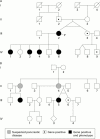Expression and penetrance of the hereditary pancreatitis phenotype in monozygotic twins
- PMID: 11247900
- PMCID: PMC1728254
- DOI: 10.1136/gut.48.4.542
Expression and penetrance of the hereditary pancreatitis phenotype in monozygotic twins
Abstract
Background: Hereditary pancreatitis (HP) is a rare autosomal dominant disorder with variable expression and an overall lifetime penetrance of 80%. We hypothesised that (1) monozygotic twins within similar environments would develop the typical signs of HP at a similar age, and (2) if penetrance were due to modifier genes or environment, all twin pairs would be concordant for expression of HP.
Aim: Identify monozygotic twins with HP and determine the penetrance, concordance, and age of onset of symptoms.
Methods: Twins from HP kindreds were identified from the Midwest Multicenter Pancreatic Study group database, referrals, and literature searches. Each twin set was assessed for phenotypic expression, concordance, and difference in age of phenotypic onset of pancreatitis. The difference in onset of symptoms for symptomatic affected non-twin sibling pairs as well as non-twin pairs that were mutation, sex, and age matched were calculated as two comparison groups.
Results: Seven of 11 monozygotic pairs identified were suitable for evaluation and four were concordant for pancreatitis. Forty eight affected sibling pairs and 33 pairs of mutation, sex, and age matched (cationic trypsinogen R122H (30 pairs) and N29I (three pairs)) subjects were identified for comparison groups. The median (quartiles Q1, Q3) difference in the age of phenotypic onset in the concordant twins was 1 (0, 2.4) years, 2 (1, 6) for the affected siblings, and 7 (2, 15) years in the comparison control group. Three of the seven sets of twins (43%) were discordant for phenotypic expression of pancreatitis. The overall penetrance in the seven pairs of monozygotic twins was 78.6%.
Conclusions: Genetic and/or environmental factors contribute to expression and age of onset of HP. Nuclear genes or general environmental factors alone cannot explain the 80% penetrance. Determining the mechanism of non-penetrance may help in developing a strategy to prevent the phenotypic expression of pancreatitis in individuals with an underlying genetic predisposition.
Figures

Similar articles
-
A 93 year old man with the PRSS1 R122H mutation, low SPINK1 expression, and no pancreatitis: insights into phenotypic non-penetrance.Gut. 2006 May;55(5):728-31. doi: 10.1136/gut.2005.067959. Epub 2005 Dec 14. Gut. 2006. PMID: 16354799 Free PMC article.
-
The variable phenotype of the p.A16V mutation of cationic trypsinogen (PRSS1) in pancreatitis families.Gut. 2010 Mar;59(3):357-63. doi: 10.1136/gut.2009.186817. Epub 2009 Dec 1. Gut. 2010. PMID: 19951905
-
Neuroanatomic variation in monozygotic twin pairs discordant for the narrow phenotype for autism.Am J Psychiatry. 2004 Mar;161(3):539-46. doi: 10.1176/appi.ajp.161.3.539. Am J Psychiatry. 2004. PMID: 14992981
-
[Hereditary pancreatitis].Ugeskr Laeger. 2003 Jan 27;165(5):447-51. Ugeskr Laeger. 2003. PMID: 12599840 Review. Danish.
-
Molecular basis of hereditary pancreatitis.Eur J Hum Genet. 2000 Jul;8(7):473-9. doi: 10.1038/sj.ejhg.5200492. Eur J Hum Genet. 2000. PMID: 10909845 Review.
Cited by
-
Genetic factors in pancreatitis.Curr Gastroenterol Rep. 2003 Apr;5(2):105-9. doi: 10.1007/s11894-003-0078-7. Curr Gastroenterol Rep. 2003. PMID: 12631449 Review.
-
De novo deletion in MECP2 in a monozygotic twin pair: a case report.BMC Med Genet. 2011 Aug 27;12:113. doi: 10.1186/1471-2350-12-113. BMC Med Genet. 2011. PMID: 21871116 Free PMC article.
-
Mutations of human cationic trypsinogen (PRSS1) and chronic pancreatitis.Hum Mutat. 2006 Aug;27(8):721-30. doi: 10.1002/humu.20343. Hum Mutat. 2006. PMID: 16791840 Free PMC article. Review.
-
A 93 year old man with the PRSS1 R122H mutation, low SPINK1 expression, and no pancreatitis: insights into phenotypic non-penetrance.Gut. 2006 May;55(5):728-31. doi: 10.1136/gut.2005.067959. Epub 2005 Dec 14. Gut. 2006. PMID: 16354799 Free PMC article.
-
Value of genetic testing in the management of pancreatitis.Gut. 2004 Nov;53(11):1710-7. doi: 10.1136/gut.2003.015511. Gut. 2004. PMID: 15479696 Free PMC article. Review. No abstract available.
References
Publication types
MeSH terms
Grants and funding
LinkOut - more resources
Full Text Sources
Medical
Research Materials
Miscellaneous
